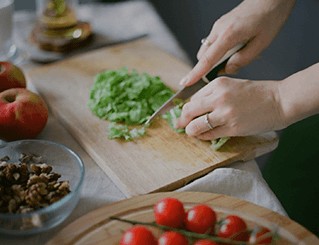Let’s Eat for the Health of It*
Article from the CDC
Build a Healthy Plate
Before you eat, think about what goes on your plate or in your cup or bowl. Foods like vegetables, fruits, whole grains, low-fat dairy products, and lean protein foods contain the nutrients you need without too many calories. Try some of these options.
Make Half Your Plate Fruits and Vegetables
- Eat red, orange, and dark-green vegetables, such as tomatoes, sweet potatoes, and broccoli, in main and side dishes.
- Eat fruit, vegetables, or unsalted nuts as snacks—they are nature’s original fast foods.
Make at Least Half Your Grains Whole
- Choose 100% whole-grain cereals, breads, crackers, rice, and pasta.
- Check the ingredients list on food packages to find whole-grain foods.
Vary Your Protein Food Choices
- Twice a week, make seafood the protein on your plate.
- Eat beans, which are a natural source of fiber and protein.
- Keep meat and poultry portions small and lean.
Cut Back on Foods High in Solid Fats, Added Sugars, and Salt
Many people eat foods with too much solid fats, added sugars, and salt (sodium). Added sugars and fats load foods with extra calories you don’t need. Too much sodium may increase your blood pressure.
Choose Foods and Drinks with Little or No Added Sugar
- Drink water instead of sugary drinks. There are about 10 packets of sugar in a 12-ounce can of soda.
- Select fruit for dessert. Eat sugary desserts less often.
- Choose 100% fruit juice instead of fruit-flavored drinks.
Look Out for Salt (Sodium) in Foods You Buy—It All Adds Up
- Compare sodium in foods like soup, bread, and frozen meals—and choose the foods with lower numbers.
- Add spices or herbs to season food without adding salt.
Eat Fewer Foods that Are High in Solid Fats
- Make major sources of saturated fats—such as cakes, cookies, ice cream, pizza, cheese, sausages, and hot dogs—occasional choices, not everyday foods.
- Select lean cuts of meats or poultry and fat-free or low-fat milk, yogurt, and cheese.
- Switch from solid fats to oils when preparing food.
Examples of solid fats and oils
Solid Fats
- Beef, pork, and chicken fat
- Butter, cream, and milk fat
- Coconut, palm, and palm kernel oils
- Hydrogenated oil
- Partially hydrogenated oil
- Shortening
- Stick margarine
Oils
- Canola oil
- Corn oil
- Cottonseed oil
- Olive oil
- Peanut oil
- Safflower oil
- Sunflower oil
- Tub (soft) margarine
- Vegetable oil
Eat the Right Amount of Calories for You
Everyone has a personal calorie limit. Staying within yours can help you get to or maintain a healthy weight.
People who are successful at managing their weight have found ways to keep track of how much they eat in a day, even if they don’t count every calorie.
- Think before you eat… is it worth the calories?
- Avoid oversized portions.
- Use a smaller plate, bowl, and glass.
- Stop eating when you are satisfied, not full.
Cook more often at home, where you are in control of what’s in your food.
When Eating Out, Choose Lower Calorie Menu Options
- Check posted calorie amounts.
- Choose dishes that include vegetables, fruits, and/or whole grains.
- Order a smaller portion or share when eating out.
Write down what you eat to keep track of how much you eat.
Use Food Labels to Help You Make Better Choices
Most packaged foods have a Nutrition Facts label and an ingredients list. For a healthier you, use this tool to make smart food choices quickly and easily.
Check for calories. Be sure to look at the serving size and how many servings you are actually consuming. If you double the servings you eat, you double the calories.
Choose foods with lower calories, saturated fat, trans fat, and sodium.
Check for added sugars using the ingredients list. When a sugar is close to first on the ingredients list, the food is high in added sugars. Some names for added sugars include sucrose, glucose, high fructose corn syrup, corn syrup, maple syrup, and fructose.
Be Physically Active Your Way
Pick activities that you like and start by doing what you can.
*Be sure to check with your healthcare professional before starting a weight loss plan.
Adapted from the Centers for Disease Control and Prevention. For more information on this topic visit www.cdc.gov.









